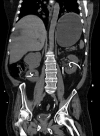Bilateral ureteric stones: an unusual cause of acute kidney injury
- PMID: 27030462
- PMCID: PMC4823542
- DOI: 10.1136/bcr-2016-214683
Bilateral ureteric stones: an unusual cause of acute kidney injury
Abstract
A 49-year-old man presented to the accident and emergency department, with a short history of vague abdominal pain, abdominal distension and two episodes of frank haematuria. A plain chest film showed dilated loops of large bowel and blood results on admission showed an acute kidney injury (stage 3). A diagnosis of bowel obstruction was made initially but a CT scan of the abdomen showed bilateral obstructing calculi. After initial resuscitation, the patient had bilateral ultrasound-guided nephrostomies and haemofiltration. He later underwent bilateral antegrade ureteric stenting. A decision will later be made on whether or not he is fit enough to undergo ureteroscopy and laser stone fragmentation.
2016 BMJ Publishing Group Ltd.
Figures
Similar articles
-
Anuria and acute kidney injury: an uncommon case of bilateral synchronous ureteric calculi.Am J Emerg Med. 2016 Nov;34(11):2256.e1-2256.e2. doi: 10.1016/j.ajem.2016.05.036. Epub 2016 May 18. Am J Emerg Med. 2016. PMID: 27241565 No abstract available.
-
Noncontrast multidetector-row computed tomography scanning for detection of radiolucent calculi in acute renal insufficiency caused by bilateral ureteral obstruction of ceftriaxone crystals.J Xray Sci Technol. 2012;20(1):11-6. doi: 10.3233/XST-2012-0315. J Xray Sci Technol. 2012. PMID: 22398584
-
[Fragmentation of ureteral calculi using a holmium YAG laser].Prog Urol. 1998 Apr;8(2):201-5. Prog Urol. 1998. PMID: 9615928 French.
-
Management of obstructive calcular anuria with acute renal failure in children less than 4 years in age: a protocol for initial urinary drainage in relation to planned definitive stone management.J Pediatr Urol. 2014 Dec;10(6):1126-32. doi: 10.1016/j.jpurol.2014.04.013. Epub 2014 Jun 8. J Pediatr Urol. 2014. PMID: 24953544
-
Management of ureteric stones.Eur Urol. 2004 Jun;45(6):714-21. doi: 10.1016/j.eururo.2003.10.018. Eur Urol. 2004. PMID: 15149742 Review.
Cited by
-
Bilateral Ureteral Obstruction Causing Acute Kidney Injury and Resultant Metformin Toxicity.Cureus. 2021 Nov 16;13(11):e19635. doi: 10.7759/cureus.19635. eCollection 2021 Nov. Cureus. 2021. PMID: 34956761 Free PMC article.
References
-
- Grossfeld GD, Litwin MS, Wolf JS Jr et al. . Evaluation of asymptomatic microscopic hematuria in adults: the American Urological Association best practice policy—part II: patient evaluation, cytology, voided markers, imaging, cystoscopy, nephrology evaluation, and follow-up. Urology 2001;57:604–10. 10.1016/S0090-4295(01)00920-7 - DOI - PubMed
-
- Stewart A, Joyce A. Modern management of renal colic. Trends Urol Gynaecol Sex Health 2008;13:14–17. 10.1002/tre.68 - DOI
Publication types
MeSH terms
LinkOut - more resources
Full Text Sources
Other Literature Sources


